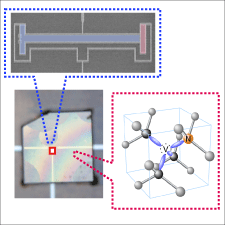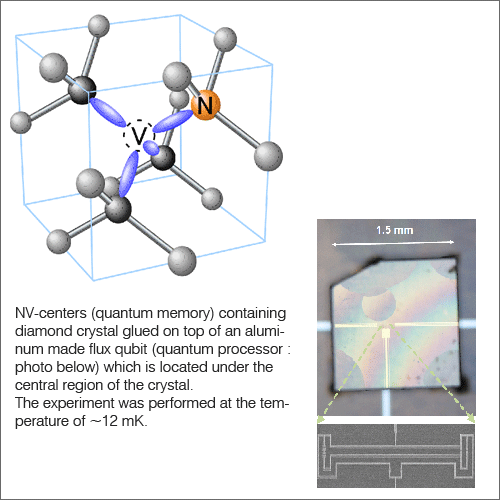Experimental demonstration of quantum memory in diamond

NTT in conjunctions with it partners from Osaka university and the National Institute of Informatics (NII) are pleased to announce a significant step towards the realization of long lived quantum memories for quantum computation in condensed matter systems. Unlike memories in a classical computers, a quantum memory has been challenging to realize, requiring cooperative interaction between different solid-state systems.
We report in a Nature paper*1 of October 13 issue that we have demonstrated strong coupling between a solid-state quantum processing unit (a flux-qubit) and a dedicated quantum memory (NV centers in diamond). These results indicate that quantum information manipulated in flux qubits can be stored to and retrieved from an ensemble of NV centers. A quantum memory is an essential component for quantum communication and information processing. Our work demonstrated that diamond is a promising candidate for a future quantum memory. This is a significant step forward in the development of a quantum computer and additionally to an interface between the microwave and optical worlds.
News & Views
http://www.nature.com/nature/journal/v478/n7368/full/478195a.html
=> Superconducting Quantum Physics Research Group

Background:
Currently there are a large number of physical systems being investigated as candidates for building quantum computers. One such extremely promising example is superconducting quantum bit based on Josephson junctions. Over the last decade many fundamental experiments have been performed and the majority of the gates required for quantum computation in this system have been demonstrated. However the experimentally reported coherence times of these qubit are likely to be insufficient for future large scale quantum computation. This has been the major concern in superconductor based quantum information devices. The natural solution is to build a dedicated quantum memory associated with each of these superconducting qubits. Atomic and molecular systems are promising candidates as they demonstrated much longer coherence times. One such particular system: electron-spin nitrogen-vacancy color centers in diamond are a natural candidate to act as a quantum memory for superconducting qubits, because of their large collective coupling and long coherence times in addition to a natural energy splitting compatible with flux-qubits. Our flux-qubit is able to coherently exchange a single quantum of energy with a macroscopic ensemble consisting of ∼ 30,000,000 NV− centers. This coupling will enable us to design a device with the merits from both systems: the fast gate operation in supreconducting qubits and the long coherence memory time in natural atoms.
Our work has been realized at NTT Basic Research Labs*2 in the group led by Dr. Kouichi Semba*3 in cooperation with Professor Norikazu Mizuochi*4 from Osaka University and Professor Kae Nemoto*5 from National Institute of Informatics.
NTT conducted the experiment to demonstrate the coherent coupling between the ensemble and the flux qubit. Osaka University contributed the generation and characterization of NV center diamond samples. NII supported the theory analysis of the experiment.
The research was supported in part by the Funding Program for World-Leading Innovative R&D on Science and Technology (FIRST), Scientific Research of Specially Promoted Research (grant no.18001002) by MEXT, JST-PRESTO, a Grant-in-Aid for Scientific Research on Innovative Areas (grant no.22102502), and Scientific Research (A) grant no. 22241025 from the Japanese Society for the Promotion of Science (JSPS).
*1 X. Zhu, S. Saito1, A. Kemp, K. Kakuyanagi, S. Karimoto, H. Nakano, W. J. Munro, Y. Tokura,M. S. Everitt, K. Nemoto, M. Kasu, N. Mizuochi & K. Semba. (2011, doi:10.1038/nature10462).
Coherent coupling of a superconducting flux qubit to an electron spin ensemble in diamond.
*2 NTT Basic Research Laboratories(NTT-BRL) is a member of NTT Science and Core Technology Laboratory Group. NTT-BRL’s aim is to explore principles creating new innovation technologies by for information communications in the field of quantum physics, quantum optics, and nano- & micro-structures.
*3 Group Leader, Superconducting Quantum Physics Research Group
*4 Professor, Mizuochi laboratory, Osaka university
*5 Professor, Quantum Information Sciences group at NII










